The book I am starting with for my research on heroes is On Heroes, Hero-Worship, and the Heroic in History ( 2013) by Thomas Carlyle with essays by a number of contributors. I chose this work to start because the title repeatedly popped up on preliminary theoretical resource searches. After reading the introduction, I know why: It argues and explores what has been termed the “Great Man” theory (i.e., history is defined by great men).
Although I think it could still be beneficial to read thiswork for my research, I don’t think it’s best to right now. The introduction provided a good overview of what Carlyle’s lectures contain, and at this point that’s all I really need from the book. That said, my next step will probably be to read Comic Books and American Cultural History: An Anthology. I need to wade around in comic book history and cultural before progressing into the modern-day superhero franchise (while engaging with more theoretical texts along the way).
As for my notes, I have uploaded a photo of them because I take notes best the old-fashioned way: by hand. I find that I retain what I read way better when I do so, and it keeps all of my notes (apart from supplement materials–which I keep, in addition to my notebook, in a research binder) together.
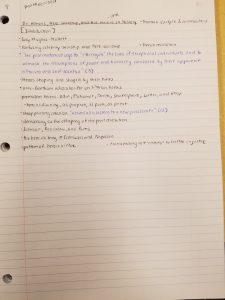
You’ll notice that I use different colored ink; I use blue ink for direct quotations and black ink for general notes, that way when I am going back through my notes I can pull quotes easily. You might also notice that my pages are numbered; my high school chemistry teacher taught us to treat notebooks much like books with table of contents and page numbers, and this method has helped keep my pages-upon-pages of notes organized and navigable. I also have the habit of writing key words in the left-hand margins of my notes, and major concepts in the upper margins. If a note or quote is particularly important, I star it. Section headings or chapters I put in brackets, and I always put the title and year of what I am reading along with author(s) on top of the first line of every corresponding page, often with (continued) in parenthesis if the notes area continuation of the same work.

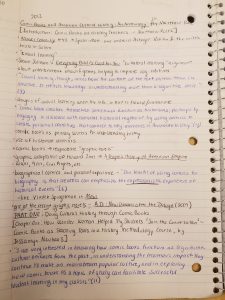
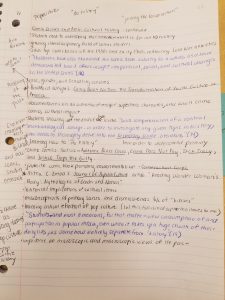
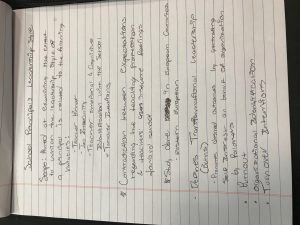
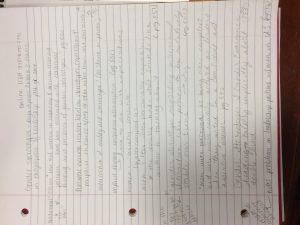 My notes differed as I was taking them this time from how they normally are because I found myself questioning everything I read. I was constantly wondering and making side notes for other things to look up during the reading. This ranged from how credible was the source, to whether or not I personally bought the argument of the author that was trying to convince me. I was careful to include page numbers and track the source where I got it, as well as note where I am in the research process so that later on, when I come back to these notes, I will see that I have hardly done any research so far (and if there is conflicting data later on, this definitely deserves a second look). However, my notes were similar in that I like taking most of my notes by had, especially when reading about things that I’m not completely familiar with.
My notes differed as I was taking them this time from how they normally are because I found myself questioning everything I read. I was constantly wondering and making side notes for other things to look up during the reading. This ranged from how credible was the source, to whether or not I personally bought the argument of the author that was trying to convince me. I was careful to include page numbers and track the source where I got it, as well as note where I am in the research process so that later on, when I come back to these notes, I will see that I have hardly done any research so far (and if there is conflicting data later on, this definitely deserves a second look). However, my notes were similar in that I like taking most of my notes by had, especially when reading about things that I’m not completely familiar with.